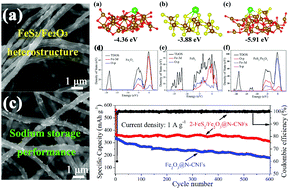Facile synthesis of carbon nanofiber confined FeS2/Fe2O3 heterostructures as superior anode materials for sodium-ion batteries†
Abstract
Sodium-ion batteries are recognized as an alternative energy storage device for lithium-ion batteries. However, the sluggish electrochemical kinetics and huge volume changes hinder their further application. In this work, FeS2/Fe2O3 heterostructures confined by carbon fibers (FeS2/Fe2O3@N-CNFs) are fabricated by the electrospinning method and a post-heat treatment with commercial Fe2O3 particles and polyacrylonitrile (PAN) as precursors. FeS2/Fe2O3 heterostructures can be easily obtained by a time-dependent sulfuration treatment. The FeS2/Fe2O3@N-CNF composite with an optimized nano-structure and composition exhibits enhanced electrochemical performance compared to the original composite (Fe2O3 confined by carbon fibers, Fe2O3/N-CNFs). Specifically, a specific capacity of 246.2 mA h g−1 is gained at current densities of 3.2 A g−1, which is much higher than that of the Fe2O3/N-CNF electrode (152.6 mA h g−1). In addition, a discharge capacity of 287.3 mA h g−1 can be maintained after 600 cycles at 1 A g−1, corresponding to a capacity retention of 82.8%. The density functional theory (DFT) calculations and kinetics analysis reveal that the heterostructures in the composite are not only beneficial for electronic conductivity, but are also favorable for the sodium adsorption ability. This work paves a practicable way to construct anode materials with excellent sodium storage performances and prolonged cyclic life.



 Please wait while we load your content...
Please wait while we load your content...